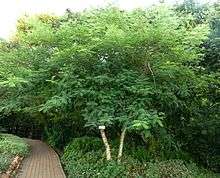''Senegalia polyacantha'' subsp. ''campylacantha''
| Senegalia polyacantha subsp. campylacantha | |
|---|---|
 | |
| Scientific classification | |
| Kingdom: | Plantae |
| Clade: | Angiosperms |
| Clade: | Eudicots |
| Clade: | Rosids |
| Order: | Fabales |
| Family: | Fabaceae |
| Genus: | Senegalia |
| Species: | S. polyacantha |
| Subspecies: | S. p. subsp. campylacantha |
| Trinomial name | |
| Senegalia polyacantha subsp. campylacantha (Hochst. ex. A.Rich.) Kyal. & Boatwr. | |
 | |
| Range of S. p. subsp. campylacantha | |
| Synonyms[1] | |
| |
Senegalia polyacantha subsp. campylacantha is a perennial tree native to Africa. Common names for it are whitethorn and witdoring.[2] It is not listed as being a threatened species. Its uses include wood and medicine.[1]
Uses
Repellent uses
The root emits chemical compounds that repel animals including crocodiles, snakes and rats.[3][4]
Medicinal purposes
Root extract of S. polycantha is useful for snakebites and is applied to wash the skin of children who are agitated at night time.[3]
Wood
The tree is good for using as firewood, but its thorns complicate its use.[4] The tree's heartwood has a density of about 705 kg/m³.[5]
References
- 1 2 ILDIS LegumeWeb
- ↑ "Acacia polyacantha subsp. campylacantha". Germplasm Resources Information Network (GRIN). Agricultural Research Service (ARS), United States Department of Agriculture (USDA). Retrieved 19 January 2018.
- 1 2 "Acacia polyacantha". www.plantzafrica.com. Retrieved 2009-01-14.
- 1 2 "Species Information". www.worldagroforestrycentre.org. Archived from the original on 2007-09-28. Retrieved 2009-01-14.
- ↑ FAO
This article is issued from
Wikipedia.
The text is licensed under Creative Commons - Attribution - Sharealike.
Additional terms may apply for the media files.